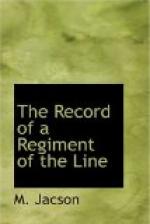The news of the relief of Kimberley was received by the garrison on February 17th, and it was reported that General French had captured five laagers.
On Sunday, the 18th, the battalion and 13th Battery, the remains of the Gloucester Regiment, and the Mountain Battery assembled as usual under “Liverpool Castle” for Divine service. The Reverend J. Tuckey officiated. The usual “extermination” service and prayers for the “Right” were said, the hymns chosen being—
There is a blessed home
Beyond this land of woe;
and
There is a green hill far away,
sung sadly to the accompaniment of Buller’s guns.
He appears to be nearer, and his shells have been bursting on a hill and ridge in the distance, Colenso way.
The following statistics are of interest:—
Early in November the garrison of Ladysmith numbered
about 13,500 men.
During the siege there were over 10,500 admissions
to hospital.
Thirty-eight men had been killed by shell fire, and 430 men had died of disease. Four shells only had accounted for nearly all the thirty-eight.
On February 19th news was sent in that General Buller had captured Cingolo Mountain and Monte Christo, and that excellent progress was being made by him. The Boers were seen trekking north all day; and in the evening Buller’s heliographs were seen flashing from Monte Christo, and two guns on the same hill firing at the Boers. With the exception of Buller’s heliograph and balloon this was the first occasion that the relieving army was seen from Ladysmith.
On February 22nd, with the intention of finding out whether there had been any reduction in the investing force, the Regiment with some mounted infantry were ordered to reconnoitre in the direction of Flag Hill. A start was made at 3.30 a.m. Some sixty Boers were encountered, and the Regiment was ordered back to camp at 6.15 a.m., fired at by the sixty Boers.
Buller’s guns were heard firing incessantly all day and every day. His shells were now seen bursting on a southern spur of Bulwana and near Intombi Camp.
During the siege the Boers conceived the idea of flooding the Ladysmith plain and the town by damming the Klip River below Intombi Camp. This dam was commenced towards the end of the siege, but was not completed when Ladysmith was relieved. It was a good target for the naval 12-pounder guns on Caesar’s Camp, which frequently fired at it. These in their turn received on such occasions a good deal of attention from the Boer big gun on Bulwana.
On the night of the 24th the 4.7 gun “Lady Anne” was again moved; this was for the fourth and the last time. On the same night very heavy rifle and Maxim gun fire was heard on the hills south of Caesar’s Camp. This continued for about one hour, when the firing was taken up by the Boer outposts all round Ladysmith, a few bullets reaching the Convalescent Camp on Convent Hill.




